
Update: This is part one of two in my series about the March 7 and April 16, 2018 Google algorithm updates. I published part two and that post can be found here.
On March 7, 2018 Google rolled out one of the biggest algorithm updates I’ve seen in a long time, which I called The Brackets Update. It reminded me of Phantom 2 from May of 2015 on several levels. That’s when I uncovered a massive update that was ultimately confirmed by Google (after I was interviewed by CNBC). Google explained that they implemented a change with how they assess quality. And that statement was incredibly important, since Google is always trying to surface the highest-quality content for users. It was the first of many quality updates that had a significant impact globally.
Now with the March 7, 2018 update, Google also confirmed the rollout. And it was a big update. Many sites were impacted globally (across categories and countries). There was a lot of volatility when the update first rolled out, and then more with subsequent tremors. For example, there was a boatload of movement on March 14 with some sites reversing and others seeing more impact in the same direction (continuing to surge or drop). It was one of the most volatile few weeks I’ve ever seen.
Well, only a few weeks after the 3/14 tremor, we had yet another broad core ranking update that rolled out. It was on April 16, and there was significant movement across sites, categories, and countries. In this two-part series, I’ll first cover what we know about the algorithm update, Google’s comments about relevancy, a history of Panda and why that could be important, The Celebrity Update from December of 2017, and more. And in part two I cover what I’ve seen with the April 16 update, including examples of surges and drops, the connection to the March 7 update, and my thoughts about what you can do as a site owner or SEO.
A quick disclaimer:
I do not work for Google. I do not have access to Google’s core ranking algorithm, bamboo, Panda, or scary Phantoms. I’m just explaining what I’ve seen after analyzing many sites impacted by algorithm updates over time, and how that compares with what I’m seeing with the latest Google updates. I have access to a lot of data across sites, categories, and countries, while also having many sites reach out to me for help after seeing movement from these updates. Nobody knows exactly what Google is refining, other than the search engineers themselves.
Examples of Movement – Big swings.
First, I’ll provide some examples of the movement I saw when the April 16 update rolled out. I have access to a large dataset of sites, and many have had quality issues in the past, so I can often see a lot of movement when big updates roll out. In addition, there are always a number of companies that reach out to me for help after seeing impact from a new update. And I also track certain niche categories very closely. Based on that data, here are some examples of impact:
Gains:



Drops:



Connection to the March 7, 2018 Update
With the April 16, 2018 update, I saw several connections to the March 7, 2018 update. For example, there were some sites that initially dropped on 3/7 that either dropped more, or they reversed. I also saw websites that initially surged on 3/7, that surged more, or reversed and dropped back down. Danny Sullivan confirmed the update by explaining it was the same type of broad update released on March 7 which was benefiting sites that were previously under-rewarded. More about that point soon.
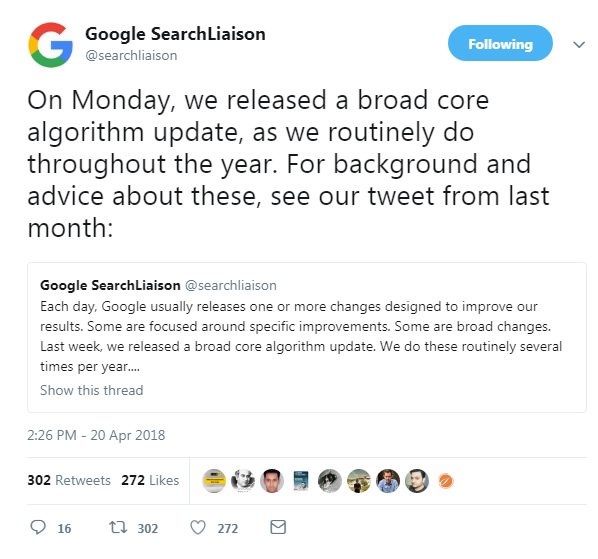
Based on Danny’s comment about the update benefiting pages that were being under-rewarded, it was interesting to see some sites reverse quickly with the 4/16 update (after seeing initial impact on 3/7). I guess they were only being rewarded for a few weeks, right? :) We know Google’s algorithms aren’t perfect, and there were clearly adjustments made after the March 7 rollout. I’ve seen this before with other major algorithm updates by the way. More about reversals later in the post.
It’s also interesting that Danny said “pages” when these updates clearly look like site-level adjustments. For example, many sites dropped or surged significantly. That’s not the effect of just certain pages being rewarded… that sure looks like a site-level adjustment. I’ll cover this when I explain John Mueller’s comments in the next section.
Relevance and site-level impact:
In a webmaster hangout video, John Mueller was asked a question about the March 7 update. He didn’t say too much about the algorithm update (which is normal), but he did explain that the update was more about relevance. When commenting about why certain sites dropped, John said, “maybe the sites aren’t seen as relevant in the overall picture of the web anymore”. And that sure backs a site-level adjustment. For example, that’s basically Google explaining that your site is not as relevant anymore for the queries at hand.
Here is the video of John explaining this (at 11:33 in the video):

Now, I don’t believe the entire update was about relevance (on both 3/7 and 4/16). Actually, it almost can’t be based on the data I have access to and some of the hits and surges I have analyzed. You can read my post about the March 7 update to learn more about all of the quality problems I saw across sites negatively impacted. I also cover sites that surged and the work they have been doing from a quality standpoint. So, there were either multiple updates pushed at once, or both algorithm updates focused on more than just relevance. That’s a good segue to my next section.
Reverse-Panda? Relevance, and the difference between “Medieval Panda” and “Current Panda”
First, when Google says anything about relevance, my Panda ears perk up. I’ve covered medieval Panda versus the core ranking Panda many times in my posts about algorithm updates. It’s an important point that I think many people miss.
Medieval Panda (pre-Panda 4.2) ate everything in its path. If your site was deemed low-quality, you better run for the hills and hope you don’t end up stuck in a bamboo forest. It wasn’t uncommon for sites to see a drop of 60%+ after medieval Panda rolled through. And the worst hit I saw was from a site that dropped 91% overnight. Yes, 91%.
Here’s an example of a severe medieval Panda hit:

But that was medieval Panda. Over the years, Panda went through a transformation and we saw the last old-school update on 10/24/14, which I picked up after Panda 4.1 rolled out. Then we saw nothing until July of 2015 with Panda 4.2. And it didn’t take long to see something was very different with our cute, black and white furry friend. For example, Google explained it was now rolling out slowly and would continually roam the web. That’s very different from rolling out on one day and having massive impact in a very short period of time.
Then in January of 2016, we found out that Panda became part of Google’s core ranking algorithm. For anyone tracking Panda closely, you could clearly see the changes. Sites weren’t getting hammered anymore, there were slight changes over time and Panda seemed to focus more on relevance than hammering sites that were low-quality. And yes, read that bolded word again. I said relevance.
Actually, Google’s Gary Illyes confirmed some of what we were seeing. During an interview with Bruce Clay, Gary explained that Panda wasn’t viewed internally as a “penalty”. It was merely trying to adjust sites that were overly-prominent for queries they shouldn’t rank for. Therefore, the days of dropping by 60% due to Panda were gone (replaced by what we called “quality updates”), and Panda became more of a relevance adjuster.
Here is a video of Gary explaining Panda adjustments:

The reason I took you through that Panda history lesson was because we might want to think of the new updates as “reverse-Panda”. Sites are benefitting since they are more relevant than other sites (which of course means that sites that are being leapfrogged are deemed less relevant).
And by the way, since Panda is part of Google core ranking algorithm, the changes that rolled out on March 7 (and now April 16) could have been a mixture of changes, which could have included Panda tweaks. We haven’t received any updates about Panda in a long time, yet we know it went through a major transformation when it became part of Google’s core ranking algorithm.
It’s hard to say for sure what exactly is going on, but don’t forget about Panda when Google talks about “relevance”. It may not be as nasty as medieval Panda, but it’s still there… and could very well be multiple versions ahead of the last Panda we knew.
Testing Celebrities: Remember The Celebrity Update on December 15, 2017?
On December 15, 2017, many official celebrity websites tanked. I wrote a post detailing my findings soon after the update rolled out. You could see those sites drop for queries directly related to the celebrity. The search visibility changes were significant, as you can see below.
The official site for Tom Cruise plummets:

Ditto for Charlie Sheen’s official site:

After sharing my post and what happened, Google’s Danny Sullivan said he would pass that on to the search engineers (or search quality team). And that he did…
SEO Inception – A swarm of quality raters to my site?
After Danny shared my post internally, I had a flurry of visits from what looked like quality raters to my blog post. There were 26 visits from raterlabs.com all to my celebrity post. That’s the first time I’ve seen that happen and it was a surreal moment. I’ve mentioned the Quality Rater Guidelines (QRG) many times in the past, but I’ve never been involved in any way. Now my blog post was being read by quality raters after the celebrity update rolled out. Cool, but very Inception-like. :)
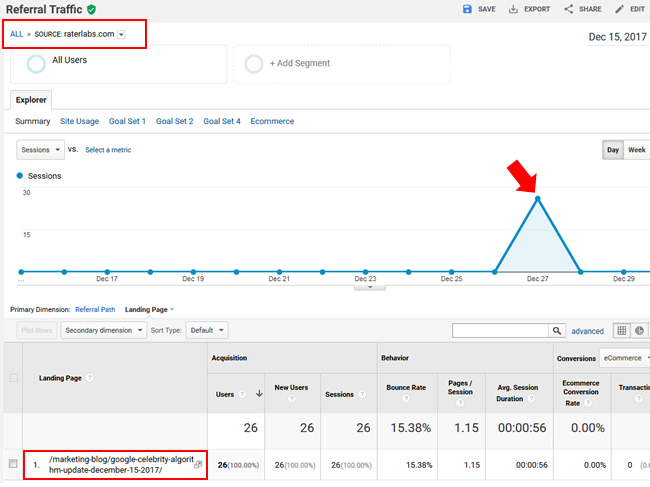
But guess what happened after that? Nothing changed. The sites that were impacted remained impacted. Therefore, the engineers were basically saying the update worked the way they wanted it to.
As I mentioned in my post about the update, many of those official celebrity sites were terrible. They were thin, didn’t contain updated information, and were basically placeholders for the celebrity on the web. On the flip side, there were other sites providing much more in-depth information, like IMDB, Wikipedia, and more. Those sites jumped up in rankings while the official celebrity sites tanked.
When asked about the update, Google’s John Mueller explained that just because those were the official celebrity websites didn’t mean that’s what users always wanted. For example, users may be searching for more in-depth information that other sites could provide. He was basically saying that the celeb sites weren’t as relevant for certain queries (which is true). So, we had a relevance sighting with that update.
Here’s the video of John explaining this (at 13:55 in the video):

Looking back now, I’m wondering if that was the start of these newer updates like we saw on March 7 and April 16. Maybe Google started by testing this new approach with specific categories. I don’t know if that’s the case, but that update looked like a smaller version of what we are seeing now. It’s just an interesting side note.
Celebrity Recovery:
If you’re wondering if any celebrity websites recovered, they did. For example, Justin Timberlake redesigned his site in late December and bounced back in January. The new site contained much stronger content and included information about his new tour. Since Justin’s tour was coming up, and his site seemed to focus on that, it could have been seen by Google’s algos as more relevant for those queries now. And if that update was like the broader updates we are seeing now, it could provide some clues as to what you can do to bounce back.
Justin Timberlake Recovers From The Celebrity Update:

But Hold On! There Were Quality Problems Too…
We know the March 7 and April 16 updates looked like site-level updates. Both updates did not seem like they were adjusting one url on a site that was deemed more relevant now. We saw adjustments that had some websites surging and others falling significantly.
When I was analyzing sites that saw both positive and negative movement due to the 3/7 and 4/16 updates, you could clearly see a number of the sites dropping WERE RELEVANT. Not only relevant, they were some of the most relevant sites on the web for the subject matter. And when checking them out in greater detail, there were a number of quality issues present. Again, you can read my post about the 3/7 update to learn about all of the quality issues I surfaced when analyzing sites that were negatively impacted.
Now, I know John said relevance, but the quality problems were hard to ignore. And if quality issues were a factor, then the updates wouldn’t be focused entirely on relevance, but about quality as well. And “quality” can mean several things, which I’ve covered heavily in my previous posts about major algorithm updates.
For example, I’ve covered the usual suspects many times when writing about quality updates. From thin content to low quality content to low quality user engagement to UX barriers to aggressive and disruptive advertising, these are the problems I overwhelmingly saw while analyzing sites negatively impacted by quality updates in the past. The following slide is from my SMX West presentation about major algorithm updates.
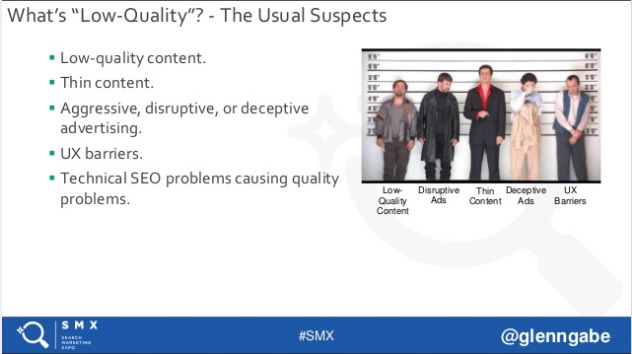
And the March 7 and April 16 updates were no different. Sure, there were some sites being leapfrogged where the content wasn’t as relevant as other sites that were rising, but I also saw the most powerful sites in a niche drop. And you cannot tell me they aren’t relevant to the subject matter. That’s crazy.
For example, there were some behemoths in health, nutrition, ecommerce, entertainment, news, recipes, automotive, and more that were leapfrogged by others in the niche. It’s an important point I wanted to make to ensure that site owners focus on the big picture, which includes quality.
A quick note about links:
I know some people thought that links could be a significant part of the April 16 update. That’s always hard to tell, but after analyzing many sites impacted by the March and April updates, I don’t believe this was the case. Some of the most powerful sites link-wise were leapfrogged during the March 7 and April 16 updates. For example, key players in each niche with millions of links (including extremely powerful links from trusted sites), were impacted. So in my opinion, I don’t believe that links had a major role here.
Example of a site with a powerful link profile negatively impacted by the April 16 update:
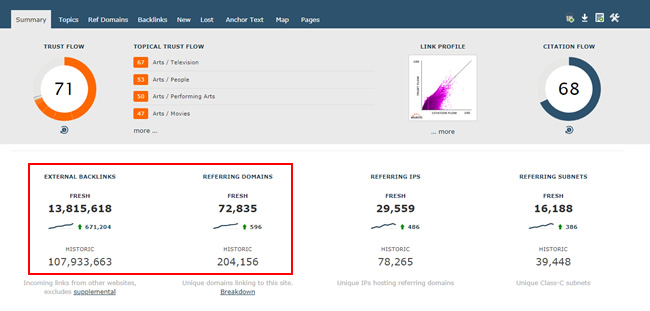
Relevance Reversals – A number of reversals from March 7 – How’s that for a change in “relevance”?
While analyzing the 4/16 update, I found a number of sites that reversed (or partially reversed) from the 3/7 update. Danny tweeted that the April 16 update was another broad update just like the March 7 update and you could clearly see the connection with the sites that reversed.
Now, tremors are nothing new. Google’s John Mueller explained this to me back during medieval Panda days. That’s when Google can follow larger updates with smaller tweaks to ensure the results are as strong as possible. That means the 4/16 update could have been adjustments to the algorithm update rolled out on 3/7. For example, check out the screenshots below:
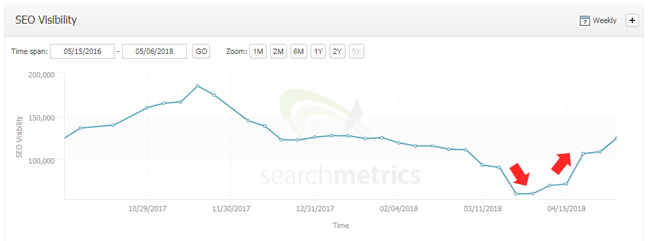
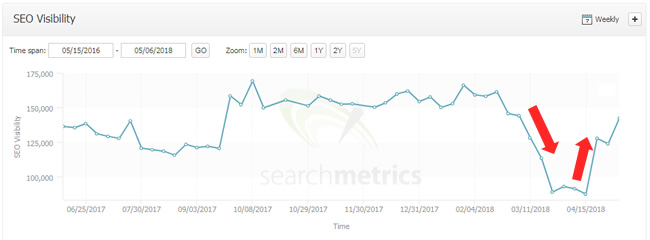
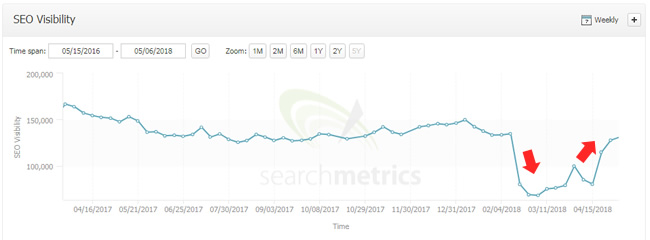
And regarding “relevance”, I guess those sites that surged back were less relevant for just a few weeks, and then became relevant again? Or sites that surged and then dropped back down had their “15 minutes of relevance fame” and then lost it? :) Again, I believe these updates were NOT just about relevance. As you’ll see in part two of my series covering examples of impact, I saw many of the usual suspects rear their ugly heads, including low-quality content, low quality user experience, aggressive and deceptive ads, UX barriers, and more.
But Glenn, Danny says to do nothing…
No, that’s not what he said. He explained there’s no quick fix you can implement to jump back up. That’s different than doing nothing. He also explained to “remain focused on building great content” and “over time it may be that your content rises relevant to others”. So don’t sit there and do nothing if you’ve seen a drop in rankings and you’ve been leapfrogged. IMPROVE YOUR SITE, CONTENT, UX, etc. I cover more about what I think you can do in part two of this series.
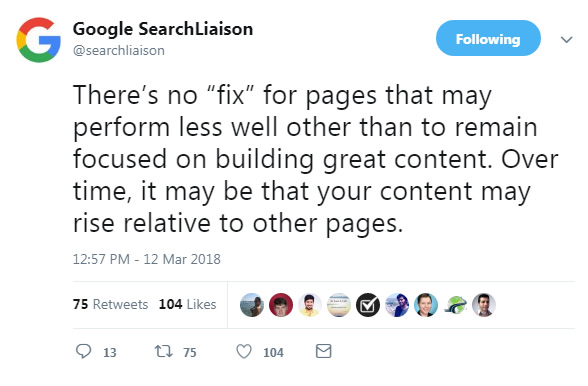
Summary: An important algorithm change that caused significant impact:
Whenever Google makes a key change to its core ranking algorithm, you can see significant impact globally. And that’s clearly what happened with the March 7 and April 16 updates. And just like with other big updates, we’ve seen some sites reverse course. Since Google’s core ranking algorithm is a black box, it’s hard to tell exactly what changed, but it sure seemed like we had clues leading up to initial rollout (which I covered in my post above).
One thing is for sure, you don’t want to be on the wrong side of these updates. Whether it’s relevance, quality, or a mixture of both, the impact to rankings and traffic is clear. In part two of my series, I take a closer look at the impact from the April 16 update, including what I think site owners and SEOs can do if their sites have been leapfrogged. You should read that post to learn more. Good luck.
GG
